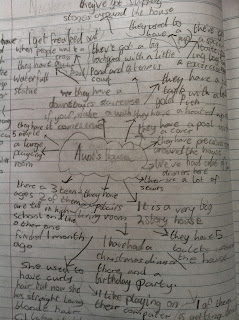The Way Forward With Brainstorming
 |
| Student's comprehensive brainstorming sample |
This post is appearing similtaneously on The Two Writing Teachers blog site where I am honoured to be this week's guest blogger. I hope you enjoy reading about brainstorming. I also hope you find strategies here that you can readily apply to your own writing workshops.
Brainstorming is a strategy that has many learning applications. In this post, as guest blogger, I want to specifically look at brainstorming within the context of writing workshop and how we can assist developing writers to use it more effectively.
It would be inaccurate to think of pre-writing as merely brainstorming. From my observations many teachers do, unfortunately. This is not to say that brainstorming is not a critical pre writing skill for young writers to acquire. In fact, it provides an excellent way to deepen student thinking around a new topic. It activates prior knowledge critical to writing success. Brainstorming allows the writer to generate ideas before organizing them. The challenge remains how to do it most effectively.
What often occurs is that students are asked to think of as many ideas as they can around a topic or idea and the result is a minimal list more recognisable as drizzle than brainstorm. ’How come they can’t do this? teachers ask.
The most experienced, proficient writer in the room needs to step forward at this point of the lesson and reveal the secrets of successful brainstorming. In the same way a magician reveals special magic to the audience, the writing teacher needs to create some sparks around brainstorming.
Adopt the notion of ‘show, don’t tell’ when revealing the brainstorming strategy to young writers. Begin by saying, ‘Young writers watch me closely, as I go about my thinking around a topic of interest to me as a writer.’
Then ask the students gathered before you to time you as you document your thinking in front of them. It is important for them to experience your thinking in action. Use a think aloud strategy, so the thoughts in your head are transmitted. After the allotted time, say three minutes, ask them to provide feedback on what they saw you doing, and heard you saying.
‘You worked really quickly.’
‘You were concentrating on your ideas.’‘You made a list.’ (my preferred style for documenting my thinking)
‘You reread your ideas to get new ones.’
‘You wrote down almost everything that came into your head.’
‘You didn’t cross anything out.’
‘You made a long list.’
'You didn’t stop thinking and writing.’
'You asked yourself questions.’
Document the feedback on a chart to draw attention to the brainstorming behaviours, you want noticed. This is such an important part of the process. Then tell them that the next step would be to organize and refine the listed items. Ask them, ‘Do I have to use every listed item?’
They understand that you are not obligated to do this. They also understand that because you have many listed ideas, there are more options at your disposal.
When I demonstrate in this way, I always sense an immediate change in the group. They are ready and primed to try this for themselves. The change is palpable. It is prudent to advise students to choose a topic they feel they know a lot about. -That way students are more likely dive straight in when their turn arrives. The challenge of the blank page just melts away under a flurry of words and phrases, clustering, mind maps, etc. I love it! When teachers see this change take place, they are often astounded that such growth in thinking appears to have taken place in the blink of an eye.
The brainstorming demonstration is without doubt, transformational. It is yet another example of the power of allowing the inexperienced writer to witness, up close and personal, how a particular aspect of the pre-writing process is conducted by a proficient writer. I am never disappointed by the response!
Don’t forget, the aim of brainstorming is quantity, not quality. We want our developing writers to deeply explore their thinking without any judgmental overlay. They should delay judgment until the list is produced. If they do this, something of interest is more likely to bubble to the surface. The lists are far more extensive and the likelihood of divergent thinking is enhanced.
Brainstorming used in conjunction with other pre-writing strategies, greatly enhances the likelihood the writing students produce will be of a higher quality when it eventually appears on the page. Now, that’s a good outcome to pursue!





Comments
Post a Comment